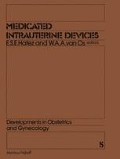Abstract
The idea of continuous intrauterine administration of progesterone for contraception, as originally presented by Dr. Antonio Scommegna, is based on four observations:
-
The estrogenic component of oral contraceptives is not essential for contraception.
-
Progestin-only mini-pills achieve satisfactory levels of contraception without inhibiting ovulation.
-
The mini-pill interferes with nidation and may change the cervical mucus, thus interfering with sperm penetration.
-
Most contraceptive failures associated with the mini-pill can be traced to poor patient compliance.
Access this chapter
Tax calculation will be finalised at checkout
Purchases are for personal use only
Preview
Unable to display preview. Download preview PDF.
References
Sievers S, Dallenbach-Hellweg G: Clinical and morphological studies in patients following insertion of a progesterone- containing IUD (Progestasert system) [in German] Geburtshilfe Frauenheilkd 36: 334 – 340, 1976.
Spellacy WN, Buhi WC: A prospective study of plasma prolactin levels in women using the progesterone-releasing intrauterine device (P-IUD). Contraception 19: 91 – 94, 1979.
Spellacy WN, Buhi WC, Birk SA: The effect of a progesterone-T intrauterine device on carbohydrate and lipid metabolism in ‘normal’ women: a three-months study. Contraception 15: 65 – 73. 1977.
Spellacy WN, Mahan CS, Buhi WC, Dumbaugh VS: Plasma prolactin levels and contraception: oral contraceptives and intrauterine devices. Contraception 17: 71 – 77, 1978.
Tillson SA, Marian M, Hudson R, Wong P, Pharriss B, Aznar R. Martinez-Manautou J: The effect of intrauterine prog-esterone on the hypothalamic-hypophyseal-ovarian axis in humans. Contraception 11: 179 – 192, 1975.
Trobough G, Guderian AM, Erickson RR, Tillson SA, Leong P, Swisher DA, Pharriss BB: The effect of exogenous intra-uterine progesterone on the amount and prostaglandin-F2α content of menstrual blood in dysmenorrheic women. J. Reprod Med 21: 153 – 158, 1978.
Zahradnik HP, Stengele E, Kraut E, Breckwoldt M: New aspects of pathogenesis and treatment of dysmenorrhea: prostaglandin-F2α level in the menstrual blood [in German] Dtsch Med Wochenschr 103: 1280 – 1273, 1978.
Editor information
Editors and Affiliations
Rights and permissions
Copyright information
© 1980 Martinus Nijhoff Publishers bv, The Hague
About this chapter
Cite this chapter
Gibor, Y. (1980). Intrauterine Contraception with the Progestasert ® System. In: Hafez, E.S.E., Van Os, W.A.A. (eds) Medicated Intrauterine Devices. Developments in Obstetrics and Gynecology, vol 5. Springer, Dordrecht. https://doi.org/10.1007/978-94-009-8872-9_14
Download citation
DOI: https://doi.org/10.1007/978-94-009-8872-9_14
Publisher Name: Springer, Dordrecht
Print ISBN: 978-94-009-8874-3
Online ISBN: 978-94-009-8872-9
eBook Packages: Springer Book Archive

